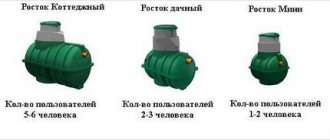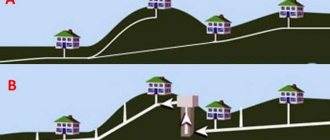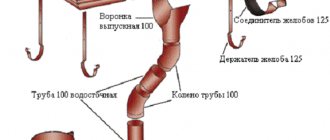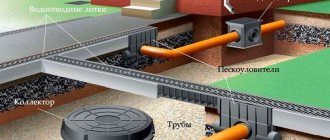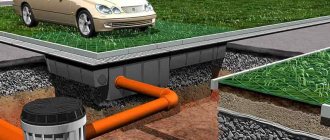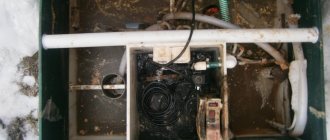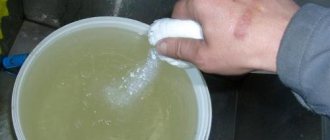Modern housing is a complex system that resembles a living organism. The house is entangled with wires and pipes in order to function normally and provide a comfortable life for the people who live here. The drainage and sewerage system plays a significant role. It is this that allows you to use the water supply normally.
The drainage system, as the name suggests, is designed to drain water. It must be laid at the construction stage, and it is important to do everything as efficiently as possible, since sewerage and drainage are one of the most important utilities. If something goes wrong, users will have to deal with a broken shower, sink, toilet, and other devices that require water to function. Naturally, it’s impossible to live like this, so we suggest finding out what a drainage system and sewerage system are, as well as how it all works.
What is water drainage and sewerage
According to the legislation of the Russian Federation, the concepts of sewerage and wastewater disposal are separated. But, in essence, water disposal is sewerage. They are part of the same system, work in symbiosis and cannot live without each other, especially in a city. For private houses there are different rules, but this does not change anything.
Let's try to find out exactly how the two mentioned concepts can be defined, and whether they are really so similar.
Dear readers!
Our articles talk about typical ways to resolve legal issues, but each case is unique. If you want to find out how to solve your specific problem, please contact the online consultant form on the right →
It's fast and free!
Or call us by phone (24/7):
If you want to find out how to solve your particular problem, call us by phone. It's fast and free!
+7 Moscow,
Moscow region
+7 Saint Petersburg,
Leningrad region
+7 Regions
(free call for all regions of Russia)
Wastewater disposal refers to the reception, transportation and treatment of wastewater that enters through a centralized drainage system. In addition, sewerage is included in the list of public services that the water utility provides to the population.- A sewer network is a complex of engineering structures that are technologically interconnected. The main purpose of the systems under consideration is to transport wastewater and sewage.
As you can see, these systems can be called similar, but they are not entirely identical. They have their own characteristics, such as, for example, we do not pay for sewerage, but sewerage is a separate line in the payment for the apartment. Although this difference does not stop there. Many people believe that sewerage is only a part of the drainage system, but cannot in any way be considered an independent unit. Is it really? We will try to find out and consider this issue in as much detail as possible.
What it is
Water disposal, sewerage - these terms are found in dialogues between specialists or regulatory documents. They are often used as synonyms and mixed with each other. However, even experts cannot always correctly identify one or another system. Both of them perform a common task - the removal of domestic, storm or industrial wastewater. Water supply networks provide the population and enterprises with drinking and industrial water. Waste water must be disposed of. These functions are jointly performed by drainage systems and sewerage networks.
Some users are confused in understanding the notation. Questions are often asked - sewerage or wastewater disposal, how to use these terms correctly. Let's look at them separately:
What problems does drainage solve?
Water disposal is a set of measures that ensure the removal of waste liquids and other waste from residential or industrial premises. The question is often asked: is drainage a sewer system, or is it a separate, independent system? The comprehensive answer is the part of the sewer network that receives and transmits wastewater into the main pipeline (collector). The system includes outlet sets of plumbing fixtures, internal sections of building systems, yard and neighborhood networks. In addition, the complex includes roof drainage, receiving gutters for storm systems, and drainage pipes.
The only controversial and unclear issue is the determination of the boundaries of the drainage area. The starting points are known - the wastewater collection points. And the external boundary of the network is nowhere defined. The issue is not fundamental, so no one has seriously addressed it.
What is sewerage
Sewer or sewer networks provide the reception, transport and disposal of waste liquids. The main tasks of networks are:
- receiving liquids from outlet elements of plumbing fixtures or industrial installations;
- supply of wastewater to treatment facilities;
- removing harmful or polluting components from them;
- discharge of treated water into water bodies.
Along with the usual spelling, the term “sewer” is sometimes found. There is no exact definition of this concept, so they are often confused. Which is correct, sewer system or drainage system? The correct answer is clear - the sewerage system. This is a complex of pipelines and wells, treatment facilities and other devices. This includes stormwater, industrial and domestic networks. They perform similar tasks, but the specifics of collecting and purifying water are significantly different. In addition, storm lines allow the discharge of conditionally clean water in extreme situations. Industrial complexes require double treatment of wastewater - before supplying it to public networks, it is first brought to the desired state in local operating systems.
Sewerage is a general concept that denotes a set of measures for organizing wastewater disposal systems. By itself, it is practically not used; only combinations are found. For example, the concept of “sewage basin” means a section of a populated area or other territory where the removal or disposal of wastewater is carried out by a single gravity-flow complex. We are talking specifically about covering the territory and ensuring the removal of waste liquids.
Also read: Installation of sewer stations: sewerage pumping station device, operating principle, installation
How to correctly say “sewage” or “sewage”
Providing a home with various communications is currently a prerequisite for a person’s comfortable stay in it. But what is the correct way to say: sewerage or sewerage?
We want to be literate, so solving this problem is fundamentally important. On many resources, water disposal is called sewerage. That is, it turns out that saying “Water disposal” would be more correct. Now it remains to find out why.
This situation can be clarified if we consider in more detail the functions of each of these systems:
- Sewerage:
- Removes waste water;
- Cleans them;
- Conducts wastewater disinfection.
- Drainage system:
- Removes wastewater from the house;
- Transports them through pipes within a city or town;
- Takes outside populated areas.
As you can see, there is a difference between these concepts. Their functionality is different, so you should think twice about how to correctly name the drainage of wastewater from the house. Both concepts have a right to life, but the confusion associated with them must stop. After all, this gives utility companies the opportunity to impose frankly unnecessary payments, which could not be paid if you understand the topic a little deeper.
Features of an autonomous sewage system
If desired, you can connect the local pipeline to the central main; to do this, you need to lay internal drainage and bring the pipes to a common riser.
The equipped autonomous sewage system has:
- - internal wiring.
- -street sewerage system.
- - storage well.
- -septic tank.
Indoor drainage consists of pipes connected to plumbing fixtures.
Pipes have different internal sections:
1.for the outlet pipe from the sink, a diameter of 40 millimeters is required.- 2. pipe drainage from the bathtub, shower, with a cross-section of 50 millimeters.
- 3. pipes from the bathroom and a riser of 110 millimeters.
Pipes for drainage are made of durable plastic of various origins. Plastic has many advantages for use. Pipes made of this material are lightweight, their installation is quick, does not require special skills, and the smoothness of the walls inside the pipes prevents the formation of silt deposits.
When installing sewerage inside a building, gray pipes are used that can transport high-temperature water. For street sewerage, orange pipes are used, which are durable because they can withstand the weight of the soil.
All connections must be equipped with sealing gaskets or lubricated with sealant. The sockets of the system are laid against the flow of liquid through the pipes. To ensure sewer turns and various branches, fittings are used, for example, couplings, crosses, tees.
Important! When connecting sockets, you should not create sharp, right angles to avoid the formation of blockages.
Tasks of water disposal and sewerage
So, when figuring out whether sewerage and sewerage are the same thing or not, it is difficult to draw an unambiguous conclusion, since even the laws of the Russian Federation cannot completely determine this fact. But most people believe that sewerage is an integral part of the water supply and sanitation system. Then we can say that, in principle, the concepts are truly equivalent. The systems perform the same tasks, it’s just that drainage is a slightly broader definition than sewerage.
For clarity, we present to you some tasks that both the first and second systems perform:
- Transports wastewater directly from the point of water collection, that is, sinks, toilets, showers, etc.;
- Transports wastewater within the house, directing it to sewer risers;
- Removes wastewater from the house;
- Transports wastewater through a pipe system to treatment facilities;
- Accumulates, defends and purifies wastewater.
This is why it is so important to correctly design the systems under consideration. If at least one of the tasks described above is not performed, then there will be no question of decent operation of the house, because wastewater can break out at any time. Believe me, you don't want to be around at this moment.
Categories
Subscribers often discharge wastewater of non-standard quality into the centralized sewerage system (hereinafter referred to as the CWS). As a result, the organization of water supply and sewerage services (hereinafter referred to as WSS) is forced to discharge wastewater into water bodies in violation of the standards for permissible discharges. Who is responsible for the final pollution of a water body?
The organization of water and wastewater services is not a source of generation of wastewater, which is received at the water treatment center, because:
1) contaminated wastewater is generated by CSV subscribers;
2) the water and wastewater services organization handles the wastewater entering the central wastewater treatment center, the quality of which, by and large, initially does not depend on the water and wastewater services organization itself;
3) The capacity of the wastewater treatment facilities of the central wastewater treatment plant is always limited, therefore, the quality of wastewater discharged into the centralized wastewater treatment plant directly affects the quality of wastewater discharged by the water and waste management organization into the water body.
By the way
If the situation were different and water and wastewater organizations could hypothetically provide the required wastewater treatment regardless of its initial quality, then there would be no: • wastewater disposal standards for wastewater composition/wastewater composition standards; • requirements for the composition and properties of wastewater, established in order to prevent negative impacts on the wastewater treatment plant; • subscriber fees for excess discharge; • subscriber fees for negative impact on the central bank.
Considering the limits of the capabilities of treatment facilities and the fact that subscribers often discharge wastewater of non-standard quality into water treatment centers, the following problem is very common: water and wastewater organizations discharge wastewater into water bodies in violation of the standards for permissible discharges .
If subscribers discharge wastewater into the central water supply center, the quality of which does not meet the established requirements (this may be an excess of wastewater disposal standards for the composition of wastewater/wastewater composition standards, or a violation of the requirements established by the rules of cold water supply and wastewater disposal), this affects and violates interests of the water and wastewater services organization.
What interests of the water and waste management organization may be violated? First of all, economic (although there is a high probability of negative administrative and legal consequences for the organization of water and wastewater services).
Within the topic under consideration, the economic interests of the water and waste management organization will be the interests associated with the lack of need:
• bear the costs of eliminating the consequences of the negative impact of wastewater on WSS facilities;
• pay a fee for negative environmental impact (hereinafter referred to as NVOS) in an “extra-limit” amount;
• compensate for damage caused to the environment (water bodies).
To protect the listed economic interests of water and wastewater services organizations, as well as to protect the environment from the negative impact of wastewater discharged into water bodies through water treatment centers, the legislator has come up with special mechanisms that are well known to business entities.
Protection Mechanisms
The first group of requirements that make up the mechanism for protecting the interests of the water and waste management organization are various requirements for wastewater quality .
Next come the requirements for the need to pay various types of fees for violating wastewater quality requirements.
The law also provides for a compensation mechanism that imposes obligations on subscribers to reimburse “extraordinary costs” of the water and utility services organization:
• actual damage caused - if the discharge of the subscriber's wastewater resulted in the destruction of structures, facilities and equipment of the central waste water treatment plant and disruption of the operation of treatment facilities that occurred as a result of violations committed by the subscriber;
• additional costs associated with an increase in fees for excess discharge of wastewater (fees for NVOS) - if the discharge of the subscriber's wastewater resulted in disruption of the operation of treatment facilities and excess discharge of wastewater into a water body;
• costs associated with compensation for damage caused to a water body - if the discharge of the subscriber's wastewater resulted in disruption of the treatment facilities and damage to the water body.
The list of protection mechanisms can be continued, but in this material we do not pursue the goal of covering this issue in detail.
We are only trying to demonstrate the following:
• water and wastewater services organizations have various tools to influence subscribers in terms of regulating the quality of wastewater discharged to the central wastewater treatment plant;
• the law stipulates that the costs of the water and wastewater services organization associated with the consequences of the discharge of wastewater of non-standard quality into the central wastewater treatment plant must be compensated.
Does this mean that the role of the water and waste management organization is reduced to a minimum?:
• accept wastewater into the central wastewater treatment plant;
• control their quality;
• clean as much as possible;
• discharge into a water body without bearing responsibility for something that the water and waste management organization seems unable to influence?
Both water and wastewater services organizations, and CSV subscribers, and especially the supervisory authorities, probably know that this is not so. Let us recall the definition of the concept of “water disposal”:
Dictionary
Wastewater disposal is the reception, transportation and treatment of wastewater using a wastewater treatment plant [1].
The water and wastewater services organization is a water user, the water quality assessment of which is standardized and limited by permitting documentation. This means that, first of all, the water and waste management organization is responsible for the quality of wastewater discharged into a water body .
All possible mechanisms of influence on CSV subscribers were invented not only to protect the interests of the water and wastewater services organization, but also for environmental purposes.
Today, Federal Law No. 416-FZ contains important instructions:
Extract from Federal Law No. 416-FZ
Article 30.2. Calculation of fees for the discharge of pollutants in excess of the established standards for the composition of wastewater and collection of the specified fee from subscribers […] 4. Funds received by the organization carrying out water disposal in the form of fees for the discharge of pollutants in excess of the established standards for the composition of wastewater are used to pay for negative impact on the environment, compensation for damage caused to water bodies, and also as a source of financing [2] for the investment program of an organization carrying out wastewater disposal, in terms of implementing measures to reduce the negative impact on the environment .
However, the cited norm came into force on 01/01/2019. Before this date, it was possible to derive the responsibility of the water and wastewater services organization for the construction, reconstruction, modernization, and technical re-equipment of treatment facilities only from the general requirements for the protection of water bodies, which must be observed by any water users.
It must be said that these requirements in practice sometimes revealed their inconsistency (despite their very imperative nature, such as, for example, the requirements related to the establishment of limits on discharges only if there are plans to reduce discharges).
When it comes to claims from supervisory authorities addressed to water and wastewater organizations on the issue of the quality of discharged wastewater, compensation for damage caused to a water body as a result of the discharge of wastewater of non-standard quality, often the key argument in the dispute between the water and wastewater services organization is the argument “the fault of the water utility in violating quality requirements there is no waste water or harm to the water body.”
To be more precise and formal: there is no cause-and-effect relationship between the actions of the water and waste management organization and the resulting consequences in the form of deterioration in the quality of water in a water body.
The logic is based, in particular, on the fact that the quality of wastewater is not entirely subject to the control of the organization carrying out wastewater disposal; The quality of wastewater is primarily the work of subscribers (collectively and individually). Consequently, the water and waste management organization should not be held liable for causing damage to a water body.
Many arbitration courts think differently, pointing out that organizations engaged in wastewater disposal must ensure wastewater treatment, and must also improve the systems of treatment facilities - that’s why they are water and wastewater services organizations.
Let's take one of the cases as an example.
Resolution of the Arbitration Court of the Far Eastern District dated November 28, 2019 in case No. A51-8049/2018
During an inspection carried out in relation to the water utility, the state environmental supervision authority discovered that the wastewater received from subscribers and discharged into the water body contained pollutants in concentrations exceeding the established requirements.
Discharge of wastewater into a water body leads to a violation of water quality standards in water bodies of fishery importance.
Vodokanal, among other things, insisted that there was no cause-and-effect relationship between its actions and the resulting consequences in the form of deterioration in the quality of water in the water body.
However, the arbitration courts of appeal and cassation instances ruled:
1) the fact that the water utility caused harm to the water body is proven by the very fact of the discharge of wastewater into the water body in excess of the maximum permissible concentration;
2) the actions of the water utility are illegal;
3) there is a cause-and-effect relationship between the illegal actions of the water utility and the damage caused to the water body.
It is interesting how the arbitration courts explained the existence of a cause-and-effect relationship, as well as the guilt of the water and waste management organization in causing harm to the water body:
The appellate court noted that the enterprise, knowing about the real consequences and the actual negative impact on the environment of its economic activities, negligently fails to act, without taking real actions to eliminate the violation of environmental legislation.
The basis for this conclusion, in our opinion, was one of the arguments of the supervisory authority:
[Enterprise - approx. author] for 9 years, charging subscribers for the provision of wastewater services, does not treat the received wastewater, does not carry out measures aimed at neutralizing the negative impact on the environment. Knowing about the real consequences and the actual negative impact of its economic activities on the environment, it negligently remains inactive, without taking real steps and actions to eliminate violations of environmental legislation.
Thus, both the supervisory authority and the arbitration courts actually found the water and wastewater services organization guilty of improperly performing the functions assigned to it for water disposal : receiving, transporting and, of course, treating wastewater .
[1] Clause 2 of Art. 2 of the Federal Law of December 7, 2011 No. 416-FZ “On Water Supply and Sanitation” (as amended on December 25, 2018; hereinafter referred to as Federal Law No. 416-FZ).
[2] Here and below it is emphasized by the author.
Features of sewerage and drainage in a private house
Let's assume that water disposal is sewerage. In principle, sewerage is an integral part of drainage, therefore we will not make any serious mistakes, since when we talk about drainage, we will also mean sewerage. But what if we talk about a system that is located in a private house?
The main feature of this system is its autonomy. That is, if a house is not connected to a public sewer system, then it does not have to pay for drainage. True, there is a nuance - the entire sewerage and drainage system must be built, if not independently, then using the services of specialists. It is expensive and difficult, but provides a comfortable life.
I'm glad that autonomous systems are not regulated. Their calculation is strictly individual, but still some general rules exist. For example, here is a short list of recommendations on what wastewater should be sent to the system:
- Household and household. The peculiarity of this wastewater is that it contains a high concentration of various chemicals, in particular detergents, etc. In addition, this type of waste can include feces, sewage of organic origin and more. To get rid of the harmful effects of the waste in question, it is necessary to use septic tanks;
- Stormwater. These include clean water. Where does it come from? As a rule, it comes through the water supply system, but much more often it originates from various precipitation, melt water after the winter period, floods and more. But the liquids in question can not only be removed, but collected and reused, for example, for filling a toilet tank or watering vegetables in a greenhouse, if we are talking about a country house with a household;
- Ground and underground waters. They are removed from the site by a drainage system to avoid flooding. They are also reusable if cleaned.
But what if the drainage system is intended not only for the home? There are many objects in a suburban area that also require separate water removal. For example, a bathhouse, a swimming pool, landscape objects. Household and household waste must not spoil the soil. Sewer discharges into a centralized drainage system can really save you from a local environmental disaster.
Drainage system for a country house
The drainage system in a country house should include systems that complement each other. These should be surface water discharge systems, roof drainage systems, and deep drainage systems.
To solve these problems, designers have developed various types of sewage systems. Below we will look at each of them in detail.
Storm drainage. Most often this is a large concrete pipe located below the frost line of the soil. It is equipped with collectors to which all drainage systems from your site are connected. Such waters are discharged into natural reservoirs.
There is also a mixed sewerage system. It is intended for the removal of not only drainage systems, but also sewerage. It also has a collector and is additionally equipped with a wastewater treatment system, which first purifies the water and then discharges it into natural reservoirs.
If you were unable to install a storm or mixed sewer system on your site, a drainage field is perfect for you. This system ensures natural and uniform absorption and drainage of precipitation into the soil.
Important: You need to build the drainage system away from buildings, this will protect you from premature destruction of the foundation.
The installation of an underground drainage system is best combined with foundation work. Groundwater and underground water are removed by the drainage system to avoid flooding. They can be reused, but must be cleaned first. Much of the system’s operation depends on its correct operation.
How to properly operate sewerage and drainage systems
Much in the operation of the system itself depends on how it is operated correctly.
And the moment of arrangement also largely influences the quality of operation of this complex mechanism for removing various waste that needs to be removed away from the house. If you do not want to start repairing the sewerage and wastewater systems in the near future, then follow the following recommendations:
- Despite the fact that it is not dangerous to combine household, household and fecal wastewater, be prepared for the fact that cleaning the sewerage will be much more difficult, because household chemicals are destructive to aerobic bacteria that carry out deep cleaning of the system;
- If you do not use a drain pipe and water seals when installing a sewer system in your house, you will most likely have an unpleasant odor in the house. It is especially strong in bathrooms and the kitchen, in general, where there is an exit from the sewer;
- High-quality drainage systems are distinguished by well-designed waste disposal into the ground, and not onto the landscape itself. In the latter case, the owner will face siltation of the site;
- It is imperative to use overflow and rotary wells to facilitate pipeline maintenance.
As is clear from all of the above, these two concepts are almost identical, although they have some features. But all this is pointless to discuss if you do not start producing a quality system at the very beginning. Only this, together with proper operation, will allow long-term and efficient use of drainage systems, both in private homes and in multi-apartment buildings.
Internal networks
Internal networks are carried out to all rooms where water is supplied - sewerage can have different configurations and dimensions. The layout of internal networks depends on the layout of the house and the location of water collection points, since all sources from which water is drained are connected to the common network.
Recently, heating and sewage systems have been installed from polymer pipes, since they are much more convenient to use than cast iron pipes. The pipes are connected into a socket or using special fittings and connected to a common sewer riser.
Advice! Sometimes a welding method is used to connect polymer pipes, but special equipment is required to perform this work.
In most cases, installation of heating and sewerage is carried out secretly, that is, they try to “hide” the pipes in the wall or “disguise” them in some other way. In this case, it is necessary to provide for inspection hatches so that if the need arises to clean the system, you do not have to disassemble the finish.
External networks
When installing an autonomous sewer system, external networks are used to transport wastewater from the house to a septic tank or other treatment facility. The pipeline is laid in a pre-prepared trench with a certain slope so that wastewater can move by gravity.
The depth of the trenches depends on the depth of soil freezing in the construction area. Design and construction are carried out in accordance with the requirements of SNiP 2.04.03-85. When designing, it is necessary to take into account local conditions that limit the possibility of constructing installations for water purification by soil filtration.
Sanitary standards prohibit the discharge of water from a septic tank onto the ground without preliminary purification. They need to be sent to filter wells or filtration fields. The difference between these structures is their depth. Therefore, when choosing an option, you need to take into account the groundwater level.
Advice! To save on earthworks and avoid preparing deep trenches for laying external sewer networks, pipe insulation is used.
In addition to the pipeline itself, external networks also include wells. They are:
- Auditing. They are used to monitor the operation of the system and, if necessary, to clean the pipeline. They are installed every 15-20 meters on straight sections of networks.
- Rotary. They need to be done at turning points, since blockages most often occur in these places.
- Drops. The installation of differential sewer wells is planned in places where there is a difference in relief.
Wastewater reservoir
The external sewerage pipeline ends at the entrance to the treatment plant or to the central collector. But since the construction of a private house, as a rule, uses autonomous sewerage and heating, connection to central networks is possible only in rare cases.
To ensure the operation of autonomous heating, a boiler is used, and a septic tank is used for local wastewater treatment. You can build such an installation yourself (for example, using ready-made well rings), but it is easier to purchase a ready-made septic tank made of plastic.
Advice! When buying a septic tank, it is important to choose the right performance of the model, which depends on the level of water consumption in the house per day.
How to calculate water drainage using a meter: formula and example
If you don’t trust online calculators or just want to understand how the amount to be paid is formed, then calculate it manually. To calculate water drainage from a meter, you need to use a special formula:
SV = (DHW + cold water) x TV, where
SV – total amount to be paid; DHW – monthly hot water consumption, based on the IPU reading, m3; Cold water consumption – monthly consumption of cold water according to the meter, m3; TV – regional tariff.
This calculation is regulated by the Government Decree “On the procedure and conditions for citizens to pay for housing and utilities.” The regional tariff for each subject of the Russian Federation is individual.
For example, let’s calculate the cost of the service in Moscow. The local regional tariff (TV) is 21.90 rubles/m3. The monthly consumption indicator according to the meter is 10 cubic meters of cold water and 5 cubic meters of hot water. The total consumption of hot and cold water supply is 15 m3.
Substituting known values into the formula, we get:
(5 + 10) x 21.90 = 328.5 rubles.
The owner must repay such an account by the 20th of the next month.
If your sewer payment is late, the city water utility will issue a fine. If repayment of the debt is delayed, the organization will consider that its rights have been violated. Penalties will be accrued daily.
For those who do not want to calculate water drainage by meters themselves, there are specialized portals where you only need to enter the readings. Next, the system will display the amount to be paid.
In case of any controversial situations, you must immediately contact the Management Company for clarification. For example, if after an independent calculation it turns out that the resulting amount is less than that calculated by the city water utility. There have often been cases when employees of the Criminal Code took advantage of the inattention of conscientious citizens and entered increased testimony.
How is the fee calculated if there is no meter: example
When there is no meter, the amount on the receipt increases. Thus, monthly consumption will be calculated based on regional standards. There is no need to explain that government standards significantly exceed actual water consumption.
The calculation is made using the formula:
Regional standard * number of registered people in residential premises * tariff.
For example, in Moscow the regional standard is 11.68 m3 per person per month. It is calculated based on the standard for hot water - 4.745 m3 and cold - 6.935 m3.
Registered citizens – 2.
The regional wastewater tariff in Moscow is 21.90 rubles/m3.
Fee calculation: 11.68 * 2 * 21.90 = 511,584 rubles.
The owner will have to pay this amount if he does not have an IPU installed. After submitting the data, the payment center checks the correctness of the calculated indicator and issues a payment order. A payment slip with the estimated amount will arrive in the new month.

